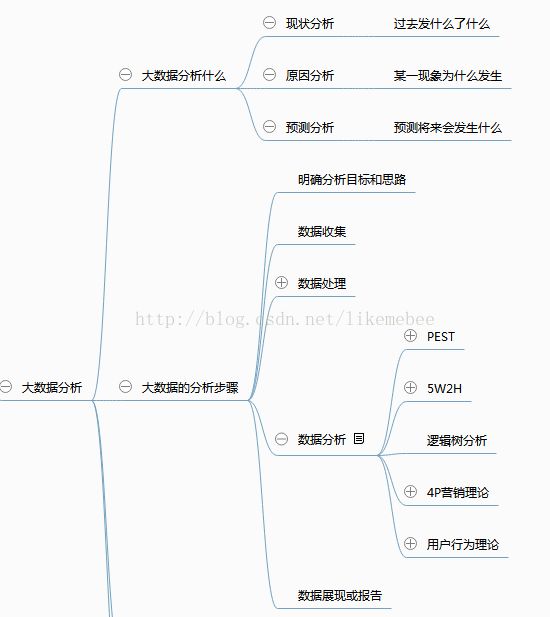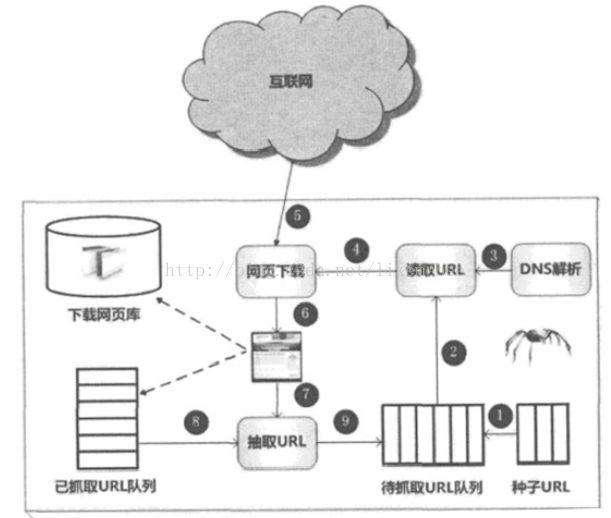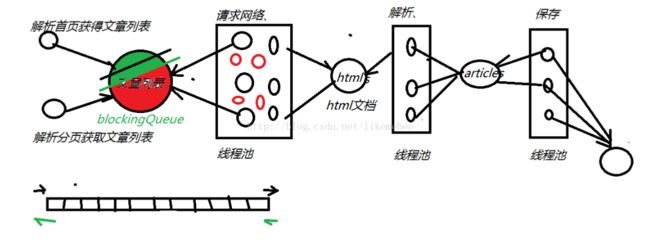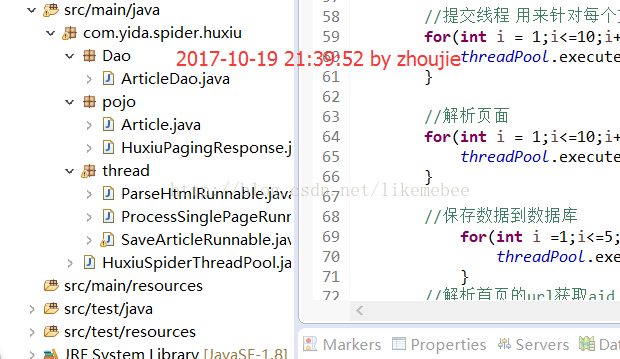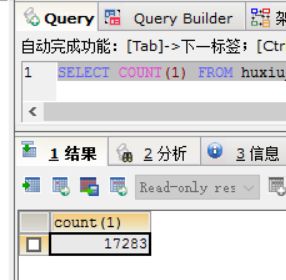深入了解Java爬虫的运用技术
首先我们需要知道关于爬虫的一些基本概念,下面我来做一些简单的介绍。
1.爬虫是什么?
爬虫又叫网络爬虫,是一种运行在互联网上为了获取数据的自动化程序或脚本
2.爬虫解决了什么问题
爬虫解决了获取数据的问题
3.爬虫爬取的数据有什么用
和搜索引擎结合使用,对数据进行分析,提取有价值的信息,得到数据的商业价值
4.爬虫的简单分类
• 通用爬虫:百度 爬取互联网所有数据的爬虫叫做通用爬虫
• 垂直爬虫:为做数据分析而爬取特定数据的爬虫叫做垂直爬虫。
总结:在互联网上,大多数都是垂直爬虫,也就是值爬取一定范围内的数据。
5.爬虫的运行原理及实现技术分析
• 1、将一个种子URL存放到队里中
• 2、从队列中读取一个URL
• 3、发起网络请求(上图4-5-6步)
o 3.1、域名解析,得到IP地址
o 3.2、发起HTTP请求
o 3.3、下载页面
• 4、解析HTML文档(上图7-8-9步)
* 解析HMTL文档获取网页中所有URL
o 分页页面是否爬取过
如果没有爬取就放入待抓取的URL队里中
总结:爬虫开发的两大核心技术
Httpclient:帮助我们更好发送网络请求
Jsoup:帮助我们更好的解析html
知道我们开发爬虫的两大核心技术后,我们简单的写一个入门级程序吧!
首先我们先导入2个核心依赖包:
<dependency>
<groupId>org.apache.httpcomponentsgroupId>
<artifactId>httpclientartifactId>
<version>4.5.3version>
dependency>
<dependency>
<groupId>org.jsoupgroupId>
<artifactId>jsoupartifactId>
<version>1.10.3version>
dependency>
使用Httpclient来发送一个Get请求:
package com.yida.spider.httpclient;
import java.io.IOException;
import org.apache.http.HttpEntity;
import org.apache.http.client.methods.CloseableHttpResponse;
import org.apache.http.client.methods.HttpGet;
import org.apache.http.impl.client.CloseableHttpClient;
import org.apache.http.impl.client.HttpClients;
import org.apache.http.util.EntityUtils;
public class HttpClientGet {
public static void main(String[] args) throws Exception {
//1.指定一个url
String url = "https://www.tianyancha.com/";
//2.创建一个默认的httpclient对象
CloseableHttpClient httpClient = HttpClients.createDefault();
//3.如果是get请求那就创建一个get对象
HttpGet httpGet = new HttpGet(url);
httpGet.setHeader("user-agent", "Mozilla/5.0 (Windows NT 6.1; WOW64) AppleWebKit/537.36 (KHTML, like Gecko) Chrome/50.0.2661.102 Safari/537.36");
//4.发起请求
CloseableHttpResponse execute = httpClient.execute(httpGet);
//5.获取数据
HttpEntity entity = execute.getEntity();
//6.打印数据
String html = EntityUtils.toString(entity,"utf-8");
System.out.println(html);
}
}
使用Httpclient发送一个post请求:
package com.yida.spider.httpclient;
import java.io.IOException;
import java.util.ArrayList;
import org.apache.http.HttpEntity;
import org.apache.http.client.ClientProtocolException;
import org.apache.http.client.entity.UrlEncodedFormEntity;
import org.apache.http.client.methods.CloseableHttpResponse;
import org.apache.http.client.methods.HttpPost;
import org.apache.http.impl.client.CloseableHttpClient;
import org.apache.http.impl.client.HttpClients;
import org.apache.http.message.BasicNameValuePair;
import org.apache.http.util.EntityUtils;
public class HttpClientPost {
public static void main(String[] args) throws Exception {
//1.指定一个url
String url = "https://www.tianyancha.com/login";
//2.创建一个默认的httpclient对象
CloseableHttpClient httpClient = HttpClients.createDefault();
//3.如果是post请求那就创建一个post对象
HttpPost httpPost = new HttpPost(url);
//set header
httpPost.setHeader("user-agent", "Mozilla/5.0 (Windows NT 6.1; WOW64) AppleWebKit/537.36 (KHTML, like Gecko) Chrome/50.0.2661.102 Safari/537.36");
ArrayList basicNameValuePairs = new ArrayList();
//设置参数(设置登录名和密码实现自动登录)
basicNameValuePairs.add(new BasicNameValuePair("username", "zhoujie"));
basicNameValuePairs.add(new BasicNameValuePair("password", "1314520"));
httpPost.setEntity(new UrlEncodedFormEntity(basicNameValuePairs));
CloseableHttpResponse execute = httpClient.execute(httpPost);
HttpEntity entity = execute.getEntity();
String html = EntityUtils.toString(entity,"utf-8");
System.out.println(html);
}
}
使用Httpclient发送了get或者post请求后,给我们返回的其实是一个html文档对象,我们需要提取html文档里面有用的数据,可以使用js的getElementById等操作dom的方式来获取我们想要的数据,但是不推荐使用此方法,太繁琐,不方便,这里给大家推荐的是jsoup来解析,使用jsoup可直接解析某个URL地址、HTML文本内容。它提供了一套非常省力的API,可通过DOM,CSS以及类似于jQuery的操作方法来取出和操作数据。
一下 既然我们已经知道了这2大核心技术的基本用法,是不是 该来运用一下呢!接下来给大家做一个比较高级的案例,挑战一下自己吧!!!案例演示的是爬取虎嗅网站的所有新闻数据,爬取之前先进行一下要使用的技术点分析。
①爬取的新闻数据这里我们选择放在mysql数据库里,由于mybatis框架比较大 ,我们这里仅仅演示的是一个案例,所以这里 采用的是Spring自带的jdbctmplate来操作 数据库 就可以了。
②爬取 一个网站所有的新闻数据这个量是十分庞大的,为了提高我们的爬取速度,我们使用多线程来提高我们爬取新闻数据的速度,又由于创建和销毁线程开销很大,可能需要上千个时钟周期,为了避免cpu花费不必要的时间在这上面,由此使用线程池的技术。
③我们爬取新闻的数据 过程分析:首先进入虎嗅首页(http://www.huxiu.com),按F12进入开发者模式查看新闻数据源码。发现每一条新闻数据div有一个data-id的属性对应一串数据,比如是 aid,点开几条新闻数据进行分析,我们惊奇的发现新闻的详情页url的格式是String url = “https://www.huxiu.com/article/“+aid+”.html”;那么我们先把首页所有的新闻列的data-id的属性爬取出来放进 一个消息队列里(ArrayBlockingQueue消息队列这里不做过多的介绍,有不清楚的可以留言,有必要的话我可以单独开一篇文章来进行说明),然后一直往下拉,发现虎嗅新闻的网站分页是点击加载更多来进行一个ajax请求,来获取分页数据,然后分析出分页请求必要的三个参数,由此可以进行分页数据的请求,获取所有的aid后,就可以进行详情页的url解析了,开多线程来 解析新闻的详情页,然后将解析出来的html文档放进 articleHtmlQueue消息队列中,后面的分析过程都是一样的,按照此思路进行分析下去 。。。。。。。。。。。。(略)为此结合下面的一张图来帮助大家的理解:
下面先给大家看一下整个案例的项目结构:
然后项目所需依赖 pom.xml如下 :
<project xmlns="http://maven.apache.org/POM/4.0.0" xmlns:xsi="http://www.w3.org/2001/XMLSchema-instance" xsi:schemaLocation="http://maven.apache.org/POM/4.0.0 http://maven.apache.org/xsd/maven-4.0.0.xsd">
<modelVersion>4.0.0modelVersion>
<groupId>com.yida.spidergroupId>
<artifactId>spider_huxiuartifactId>
<version>0.0.1-SNAPSHOTversion>
<dependencies>
<dependency>
<groupId>org.apache.httpcomponentsgroupId>
<artifactId>httpclientartifactId>
<version>4.5.3version>
dependency>
<dependency>
<groupId>org.jsoupgroupId>
<artifactId>jsoupartifactId>
<version>1.10.3version>
dependency>
<dependency>
<groupId>org.springframeworkgroupId>
<artifactId>spring-jdbcartifactId>
<version>4.2.6.RELEASEversion>
dependency>
<dependency>
<groupId>mysqlgroupId>
<artifactId>mysql-connector-javaartifactId>
<version>5.1.41version>
dependency>
<dependency>
<groupId>c3p0groupId>
<artifactId>c3p0artifactId>
<version>0.9.1.2version>
dependency>
<dependency>
<groupId>com.alibabagroupId>
<artifactId>fastjsonartifactId>
<version>1.2.31version>
dependency>
<dependency>
<groupId>com.google.code.gsongroupId>
<artifactId>gsonartifactId>
<version>2.8.1version>
dependency>
dependencies>
<build>
<plugins>
<plugin>
<groupId>org.apache.maven.pluginsgroupId>
<artifactId>maven-compiler-pluginartifactId>
<version>3.1version>
<configuration>
<source>1.8source>
<target>1.8target>
<encoding>utf-8encoding>
configuration>
plugin>
plugins>
build>
project>封装新闻数据的pojo类(这里为了方便,全部使用的String):
package com.yida.spider.huxiu.pojo;
public class Article {
private String id;
private String url;
private String title;
private String author;
private String createTime;
private String pl;
private String zan;
private String sc;
private String content;
public String getId() {
return id;
}
public void setId(String id) {
this.id = id;
}
public String getUrl() {
return url;
}
public void setUrl(String url) {
this.url = url;
}
public String getTitle() {
return title;
}
public void setTitle(String title) {
this.title = title;
}
public String getAuthor() {
return author;
}
public void setAuthor(String author) {
this.author = author;
}
public String getCreateTime() {
return createTime;
}
public void setCreateTime(String createTime) {
this.createTime = createTime;
}
public String getPl() {
return pl;
}
public void setPl(String pl) {
this.pl = pl;
}
public String getZan() {
return zan;
}
public void setZan(String zan) {
this.zan = zan;
}
public String getSc() {
return sc;
}
public void setSc(String sc) {
this.sc = sc;
}
public String getContent() {
return content;
}
public void setContent(String content) {
this.content = content;
}
@Override
public String toString() {
return "Article [url=" + url + ", title=" + title + ", author=" + author + ", createTime=" + createTime
+ ", pl=" + pl + ", zan=" + zan + ", sc=" + sc + ", content=" + content + "]";
}
}
封装分页数据所需的HuxiuPagingResponse类:
package com.yida.spider.huxiu.pojo;
public class HuxiuPagingResponse {
private String data;
private String last_dateline;
private String msg;
private String result;
private String total_page;
public String getData() {
return data;
}
public void setData(String data) {
this.data = data;
}
public String getLast_dateline() {
return last_dateline;
}
public void setLast_dateline(String last_dateline) {
this.last_dateline = last_dateline;
}
public String getMsg() {
return msg;
}
public void setMsg(String msg) {
this.msg = msg;
}
public String getResult() {
return result;
}
public void setResult(String result) {
this.result = result;
}
public String getTotal_page() {
return total_page;
}
public void setTotal_page(String total_page) {
this.total_page = total_page;
}
@Override
public String toString() {
return "HuxiuPagingResponse [data=" + data + ", last_dateline=" + last_dateline + ", msg=" + msg + ", result="
+ result + ", total_page=" + total_page + "]";
}
}
操作数据库的ArticleDao:
package com.yida.spider.huxiu.Dao;
import org.springframework.jdbc.core.JdbcTemplate;
import com.mchange.v2.c3p0.ComboPooledDataSource;
import com.yida.spider.huxiu.pojo.Article;
/**
* JdbcTemplate 指定数据源
* drivermanagersource 数据源bug
* c3p0,druid
* ComboPooledDataSource
* @author zhoujie
*
*/
public class ArticleDao extends JdbcTemplate{
//通过构造方法加载数据源
public ArticleDao() {
// 创建C3P0的datasource 1.配置 2.代码
ComboPooledDataSource dataSource = new ComboPooledDataSource();
// 1.url
// 2.driver
// 3.username&password
dataSource.setUser("root");
dataSource.setPassword("root");
dataSource.setJdbcUrl("jdbc:mysql://localhost:3306/spider?characterEncoding=utf-8");
setDataSource(dataSource);
}
public void save(Article article) {
String sql = "INSERT INTO `spider`.`huxiu_article` (`id`, `title`, `author`, `createTime`, `zan`, `pl`, `sc`, `content`, `url` ) VALUES( ?,?,?,?,?,?,?,?,?)";
update(sql, article.getId(),article.getTitle(),article.getAuthor(),article.getCreateTime(),article.getZan(),article.getPl(),article.getSc(),article.getContent(),article.getUrl());
}
}
主入口HuxiuSpiderThreadPool:
package com.yida.spider.huxiu;
import java.io.IOException;
import java.util.ArrayList;
import java.util.concurrent.ArrayBlockingQueue;
import java.util.concurrent.ExecutorService;
import java.util.concurrent.Executors;
import org.apache.http.HttpEntity;
import org.apache.http.client.ClientProtocolException;
import org.apache.http.client.entity.UrlEncodedFormEntity;
import org.apache.http.client.methods.CloseableHttpResponse;
import org.apache.http.client.methods.HttpGet;
import org.apache.http.client.methods.HttpPost;
import org.apache.http.client.methods.HttpRequestBase;
import org.apache.http.impl.client.CloseableHttpClient;
import org.apache.http.impl.client.HttpClients;
import org.apache.http.message.BasicNameValuePair;
import org.apache.http.util.EntityUtils;
import org.jsoup.Jsoup;
import org.jsoup.nodes.Document;
import org.jsoup.nodes.Element;
import org.jsoup.select.Elements;
import com.google.gson.Gson;
import com.yida.spider.huxiu.Dao.ArticleDao;
import com.yida.spider.huxiu.pojo.Article;
import com.yida.spider.huxiu.pojo.HuxiuPagingResponse;
import com.yida.spider.huxiu.thread.ParseHtmlRunnable;
import com.yida.spider.huxiu.thread.ProcessSinglePageRunnable;
import com.yida.spider.huxiu.thread.SaveArticleRunnable;
public class HuxiuSpiderThreadPool {
// 保存数据
public static ArticleDao articleDao = new ArticleDao();
//创建固定线程池
private static ExecutorService threadPool = Executors.newFixedThreadPool(30);
// dataline用来做分页的请求
private static String dateLine = null;
//队列---从首页和分页解析出来的文章url,存放在这个队列中
public static ArrayBlockingQueue urlQueue = new ArrayBlockingQueue(1000);
//队列---每个文章解析出来的html文档,放在这个队列中
public static ArrayBlockingQueue articleHtmlQueue = new ArrayBlockingQueue<>(1000);
//队列---每个文章的内容,也就是article对象,存放这个队列中
public static ArrayBlockingQueue articleContentQueue = new ArrayBlockingQueue(1000);
public static void main(String[] args) {
//提交线程 用来针对每个文章的url ----进行网络请求
for(int i = 1;i<=10;i++){
threadPool.execute(new ProcessSinglePageRunnable());
}
//解析页面
for(int i = 1;i<=10;i++){
threadPool.execute(new ParseHtmlRunnable());
}
//保存数据到数据库
for(int i =1;i<=5;i++){
threadPool.execute(new SaveArticleRunnable());
}
//解析首页的url获取aid
processIndexHtml();
//解析分页的url
processPageHtml();
}
/**
* 解析分页的url
*/
private static void processPageHtml() {
for(int page = 2;page<=1615;page++){
//编写分页
String pageUrl = "https://www.huxiu.com/v2_action/article_list";
System.out.println(page);
//发送一个post请求
HttpPost httpPost = new HttpPost(pageUrl);
//设置参数
ArrayList parameters = new ArrayList();
parameters.add(new BasicNameValuePair("huxiu_hash_code","2d9f6e6435e2b71a449ac39a46afe24d"));
parameters.add(new BasicNameValuePair("page", page+""));
parameters.add(new BasicNameValuePair("last_dateline", dateLine));
try {
httpPost.setEntity(new UrlEncodedFormEntity(parameters));
String jsonText = getHtmlByRequest(httpPost);
//将json转换为对象
Gson gson = new Gson();
HuxiuPagingResponse huxiuPagingResponse = gson.fromJson(jsonText, HuxiuPagingResponse.class);
// 每一次请求,都需要解析出新的dataLine
dateLine = huxiuPagingResponse.getLast_dateline();
// 获取数据
String htmlData = huxiuPagingResponse.getData();
Document doc = Jsoup.parse(htmlData);
// 解析出div的某个属性data-id
Elements aidElements = doc.select("div[data-aid]");
// 依次得到每个新闻的aid
for (Element element : aidElements) {
String aid = element.attr("data-aid");
urlQueue.put(aid);
}
} catch (Exception e) {
System.out.println("出错的页码是:"+page);
e.printStackTrace();
}
}
}
/**
* 执行post或者get请求的方法
* @author zhoujie
* @param httpPost
* @throws IOException
* @throws ClientProtocolException
*/
public static String getHtmlByRequest(HttpRequestBase request) throws ClientProtocolException, IOException {
//创建httpclient对象
CloseableHttpClient httpClient = HttpClients.createDefault();
//设置user-agent
request.setHeader("User-Agent","Mozilla/5.0 (Windows NT 10.0; WOW64) AppleWebKit/537.36 (KHTML, like Gecko) Chrome/55.0.2883.87 Safari/537.36");
CloseableHttpResponse closeableHttpResponse = httpClient.execute(request);
String html = null;
if(closeableHttpResponse.getStatusLine().getStatusCode() == 200){
//得到服务端返回的二进制数据
HttpEntity entity = closeableHttpResponse.getEntity();
//将二进制数据转化成字符串
html = EntityUtils.toString(entity,"utf-8");
return html;
}
return html;
}
/**
* 解析首页的url获取aid
*/
private static void processIndexHtml() {
//准备一个url
String url = "https://www.huxiu.com/";
//创建httpclient对象
CloseableHttpClient httpClient = HttpClients.createDefault();
//发送一个get请求
HttpGet httpGet = new HttpGet(url);
//设置user-agent
//User-Agent:
httpGet.setHeader("User-Agent","Mozilla/5.0 (Windows NT 10.0; WOW64) AppleWebKit/537.36 (KHTML, like Gecko) Chrome/55.0.2883.87 Safari/537.36");
String html = null;
try {
//执行get请求
CloseableHttpResponse closeableHttpResponse = httpClient.execute(httpGet);
//得到服务端返回的二进制数据
HttpEntity response = closeableHttpResponse.getEntity();
//将二进制数据转化成字符串
html = EntityUtils.toString(response);
} catch (Exception e) {
e.printStackTrace();
}
//使jsoup解析html文档
Document document = Jsoup.parse(html);
//获取data_line
dateLine = document.select("[data-last_dateline]").get(0).attr("data-last_dateline");
System.out.println("第一次的分页参数dateline为:"+dateLine);
Elements elements = document.select("div[data-aid]");
for (Element e: elements){
try {
urlQueue.put(e.attr("data-aid"));
} catch (InterruptedException e1) {
System.out.println("添加 aid 到urlQueue异常" + e);
}
}
}
}
解析每个url的线程ProcessSinglePageRunnable类:
package com.yida.spider.huxiu.thread;
import org.apache.http.client.methods.HttpGet;
import com.yida.spider.huxiu.HuxiuSpiderThreadPool;
public class ProcessSinglePageRunnable implements Runnable{
@Override
public void run() {
while(true){
try {
//解析每个url
processSingleUrl();
Thread.sleep(2000);
} catch (InterruptedException e) {
// TODO Auto-generated catch block
e.printStackTrace();
}
}
}
/**
* 解析每个url
* @author zhoujie
*/
private void processSingleUrl() {
try {
String aid = HuxiuSpiderThreadPool.urlQueue.take();
//得到每个url
String url = "https://www.huxiu.com/article/"+aid+".html";
//创建get请求
HttpGet httpGet = new HttpGet(url);
//解析url得到html文档
String htmlByRequest = HuxiuSpiderThreadPool.getHtmlByRequest(httpGet);
//将得到的html文档加入到articleHtmlQueue队列中
HuxiuSpiderThreadPool.articleHtmlQueue.put(htmlByRequest);
} catch (Exception e) {
e.printStackTrace();
}
}
}
解析页面封装成article对象的线程ParseHtmlRunnable类:
package com.yida.spider.huxiu.thread;
import org.jsoup.Jsoup;
import org.jsoup.nodes.Document;
import org.jsoup.select.Elements;
import com.yida.spider.huxiu.HuxiuSpiderThreadPool;
import com.yida.spider.huxiu.pojo.Article;
public class ParseHtmlRunnable implements Runnable{
@Override
public void run() {
while(true){
parseSingleHtml();
}
}
private void parseSingleHtml() {
try {
//从articleHtmlQueue队列里得到html文档
String html = HuxiuSpiderThreadPool.articleHtmlQueue.take();
//准备封装article的对象
Article article = new Article();
//解析html
Document document = Jsoup.parse(html);
//解析文章的id
String id = document.select("ul[data-id]").get(0).attr("data-id");
article.setId(id);
//解析文章的url(直接拼接就可以了)
String url = "https://www.huxiu.com/article/"+id+".html";
article.setUrl(url);
//解析文章的title
String title = document.select("title").get(0).text();
article.setTitle(title);
System.out.println(title);
// 解析文章author author-name
Elements names = document.select(".author-name");
String name = names.get(0).text();
article.setAuthor(name);
// 解析文章发布时间
Elements dates = document.select("[class^=article-time]");
String date = dates.get(0).text();
article.setCreateTime(date);
// 解析文章 评论数
Elements pls = document.select("[class^=article-pl]");
String pl = pls.get(0).text();
article.setPl(pl);
// 解析文章 点赞数 num
Elements nums = document.select(".num");
String num = nums.get(0).text();
article.setZan(num);
// 解析文章 收藏数
Elements shares = document.select("[class^=article-share]");
String share = shares.get(0).text();
article.setSc(share);
// 解析文章正文内容 article-content-wrap
Elements content = document.select(".article-content-wrap p");
String contentText = content.text();
article.setContent(contentText);
//解析完了后吧article对象放到articleContentQueue队列中
HuxiuSpiderThreadPool.articleContentQueue.put(article);
} catch (InterruptedException e) {
// TODO Auto-generated catch block
e.printStackTrace();
}
}
}
保存数据库的SaveArticleRunnable类(注意操作数据库的线程不能开多了,一度开多了线程 而导致链接数据库的数达到最大数而导致崩溃插入不了数据!):
package com.yida.spider.huxiu.thread;
import com.yida.spider.huxiu.HuxiuSpiderThreadPool;
import com.yida.spider.huxiu.Dao.ArticleDao;
import com.yida.spider.huxiu.pojo.Article;
public class SaveArticleRunnable implements Runnable{
@Override
public void run() {
while(true){
try {
// 从articleContentQueue队列取出article对象放到数据库中
Article article = HuxiuSpiderThreadPool.articleContentQueue.take();
HuxiuSpiderThreadPool.articleDao.save(article);
} catch (InterruptedException e) {
// TODO Auto-generated catch block
e.printStackTrace();
}
}
}
}
最后运行一下我们的程序吧!等待程序跑几小时的结果!(我只跑了1个小时,查看一下趴了多少条数据吧~)
这里再来扩展一下,随着越来越多的企业开始注重数据这一块的安全性,马云说过,在过去拥有石油就是拥有财富,但是未来是大数据的时代,拥有数据就是拥有财富,人工智能、自动驾驶的小汽车(每秒产生大约100G的庞大数据)……数据更是一块宝地,相信在未来更能体现出来!
当然涉及到爬虫技术,这里介绍的只是一些,还有爬虫的攻防技术。想想如果你是虎嗅的老板,如果这些数据都是你花钱辛辛苦苦收集来的,你会让别人轻易去爬取你的数据吗?肯定是不会的!
那么如何发现爬虫呢?这里简单介绍一下(主要通过如下的技术手段):
单一IP非常规的访问频次
单一IP非常规的数据流量
大量重复简单点的网站浏览行为
只下载网页,没有后续的JS\CSS请求
设置陷阱,使用hidden属性对用户隐藏标签但爬虫可见。
判断请求头
判断cookie
自古以来 ,有攻就有受,这是自然而然的道理!那么如果我们非要去爬取数据并且避免被发现呢?(主要通过如下的技术手段)
多主机策略,分布式爬取。
调整爬取速度
通过变换IP地址或者使用代理服务器来演示
频繁修改自己的User-Agent
Header中的Cache-Control修改为no-cache
当返回状态码是403(服务器资源禁止访问),改变Header和IP。不断改变。
好了,有关爬虫的介绍就到这里了,喜欢本文的点个赞吧!
